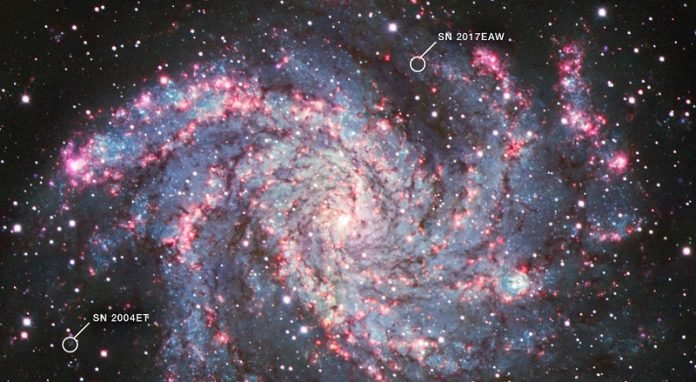
Imagine a firework show that’s so bright, it outshines an entire galaxy!
That’s what happens during a supernova – the gigantic explosion that occurs when a star dies.
These cosmic explosions aren’t just visually stunning; they also play a crucial role in the life cycle of the universe.
Meet NGC 6946, also known as the Fireworks Galaxy. Located 22 million light-years away from Earth, this galaxy has seen around ten supernovae flash within its arms over the last hundred years.
Two of these, Supernova 2004et and Supernova 2017eaw, are currently under study by researchers at Johns Hopkins University and other institutions using the James Webb Space Telescope’s Mid-Infrared Instrument (MIRI).
The researchers got a surprise when MIRI detected large amounts of dust in the remnants of each supernova.
This finding supports the idea that supernovae may have been significant contributors of dust to the early universe.
Why does dust matter in space? Well, dust is like the universe’s Lego blocks. It contains essential elements that are spread through space when a star dies. These elements help form new stars and their planets.
For years, scientists have been trying to figure out where all this dust comes from. One possibility is that it’s created by supernovae. When a star explodes, the leftover gas expands, cools, and forms dust.
“Direct evidence of this phenomenon has been slim up to this point, with our capabilities only allowing us to study the dust population in one relatively nearby supernova to date—Supernova 1987A, 170,000 light-years away from Earth,” said Melissa Shahbandeh, a postdoctoral fellow at Johns Hopkins University and the Space Telescope Science Institute.
For more distant supernovae like those in the Fireworks Galaxy, the James Webb Space Telescope’s MIRI is a vital tool, offering the right combination of wavelength coverage and sensitivity.
The new observations from the Webb telescope are a major leap forward in our understanding of how supernovae produce dust. Researchers also found that supernovae can create a lot of dust even early in their lifecycle. For instance, in Supernova 2004et, they found more than 5,000 Earth masses of dust!
Ori Fox, the program lead at the Space Telescope Science Institute, pointed out, “It’s the highest dust mass detected in supernovae since Supernova 1987A.”
Scientists know that young galaxies are packed with dust, but these galaxies aren’t old enough for medium-sized stars (like our Sun) to have created that dust as they age. Instead, more massive, short-lived stars could die and create dust quickly enough to explain the dust content.
One question that scientists have pondered is whether the dust produced by supernovae can survive the shockwaves created by the explosion. The fact that they found so much dust in the Supernovae 2004et and 2017eaw suggests that dust can survive these shockwaves, proving supernovae are indeed key dust creators.
However, researchers believe that their current estimations might just be scratching the surface. Even though the Webb telescope lets scientists measure cooler dust than ever before, there could still be undetected, colder dust hidden by outer layers of dust.
These findings aren’t just about dust. They’re also opening up new avenues for understanding the stars that caused the supernovae.
“There’s a growing excitement to understand what this dust also implies about the core of the star that exploded,” Fox said. “After looking at these particular findings, I think our fellow researchers are going to be thinking of innovative ways to work with these dusty supernovae in the future.”
Follow us on Twitter for more articles about this topic.



